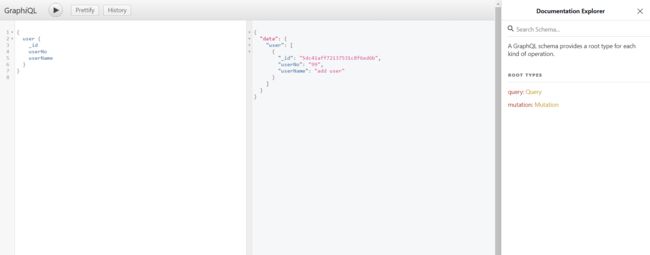Node + Egg + TS + Mongodb + Resetful + graphql
本节课内容: graphql 和 egg 定时任务
运行环境: Node ,Yarn/NPM,MongoDB
梁老师又开课啦!上节课讲到Node使用Mongodb上TS的一些操作,上节课的链接。
老规矩,本地教程的地址为:https://github.com/liangwei0101/egg-demo/tree/egg-ts-mongoose-template
egg-demo
├── app
│ ├── controller (前端的请求会到这里来!)
│ │ └── home.ts
│ ├── model(数据库表结构抽象出来的模型)
│ │ └── User.ts
│ ├── graphql(graphql文件夹)
│ │ └── mutation(所有的mutation声明文件夹)
│ │ └── schema.graphql(所有的mutation声明文件)
│ │ └── query(所有的query声明文件夹)
│ │ └── schema.graphql(所有的query声明文件)
│ │ └── user(user model的声明和实现)
│ │ └── resolver.js(声明函数的实现)
│ │ └── schema.graphql(user schema的字段声明)
│ ├── service(controller 层不建议承载过多的业务,业务重时放在service层)
│ │ └── user.ts
│ ├── schedule(定时任务文件夹)
│ │ └── addUserJob.ts
│ └── router.ts (Url的相关映射)
├── config (框架的配置文件)
│ ├── config.default.ts
│ ├── config.local.ts
│ ├── config.prod.ts
│ └── plugin.ts
├── test (测试文件夹)
│ └── **/*.test.ts
├── typings (目录用于放置 d.ts 文件)
│ └── **/*.d.ts
├── README.md
├── package.json
├── tsconfig.json
└── tslint.json
本次教程增加了schedule文件夹和graphql文件夹。
egg 使用 graphql
graphql 只是一种restful的一种不足的一种解决方案吧。它就是在 数据库操作完以后,将字段的返回权交给了用户,意思是,用户想返回哪个字段就返回哪个字段,假如说,我pc端和移动端公用一套接口,pc端需要100个字段,移动端需要10个字段,使用resetful无论你需不需要,都会给你返回,而graphql很好的解决了这个问题,因为选择权在调用方。
是不是感觉很神奇,js和ts可以共存。此教程,先上一个js和ts版本共存的,等下期教程将使用纯ts教程。使用js的问题是,在 resolver.js 中,将不能享受ts代码的代码提示和编译检查。但是很多项目可能都是之前存在的项目,此类js不能立马重构或者改动。共存也是有意义的,逐步重构或者重写吧。
// plugin.ts
const plugin: EggPlugin = {
// mongoose
mongoose: {
enable: true,
package: 'egg-mongoose',
},
// 添加 graphql
graphql: {
enable: true,
package: 'egg-graphql',
},
};
// config.default.ts
config.graphql = {
router: '/graphql',
// 是否加载到 app 上,默认开启
app: true,
// 是否加载到 agent 上,默认关闭
agent: false,
// 是否加载开发者工具 graphiql, 默认开启。路由同 router 字段。使用浏览器打开该可见。
graphiql: true,
};
config.middleware = ['graphql'];
使用user举例:
定义User schema 的返回字段
// schema
type User {
_id: String
userNo: String
userName: String
}
// 查询所有声明
type Query {
// 函数名字为user 返回为 User的数组
user: [User]
}
// Mutation 所有声明
type Mutation {
// 函数名字为user 返回为 User对象
user: User
}
Mutation 和 Query 声明函数的实现处:
'use strict';
module.exports = {
Query: {
async user(root, { }, ctx) {
return await ctx.model.User.find();
},
},
Mutation: {
async user(root, { }, ctx) {
return await ctx.model.User.create({userName: 'add user', userNo: 99});
},
}
}
然后打开浏览器输入:http://127.0.0.1:7001/graphql,没病,查询一个瞧瞧!!
egg 定时任务
定时任务和我们一般定时任务差不多。定时任务一般分两种:
- 一种是 间隔若干时间执行 某个任务
- 另一种是 某个时间点执行 某个任务
- 间隔若干时间执行(每隔60s将会执行一次)
static get schedule() {
return {
interval: '60s', // 60s 间隔
type: 'all', // 指定所有的 worker 都需要执行
};
}
async subscribe() {
const ctx = this.ctx;
console.log('每60s执行一次增加User的定时任务!!' + new Date())
const test = await ctx.service.user.addUserByScheduleTest();
console.log(test)
}
- 某个时间点执行(每个月的15号:00:00 分执行)
static get schedule() {
return {
cron: '0 0 0 15 * *', // 每个月的15号:00:00 分执行
type: 'worker', // 只指定一个随机进程执行job 防止出现数据冲突
disable: false, // 是否开启
cronOptions: {
tz: 'Asia/Shanghai',
},
};
}
async subscribe () {
const ctx = this.ctx;
console.log('每个月的15号:00:00 分执行!!' + new Date())
}
时间的配置请看:egg的官方文档。又挺晚啦,下节课给大家上graphql 的ts版本。
